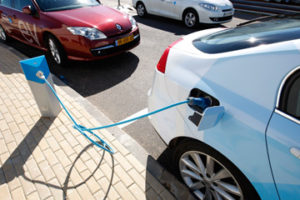 California has more electric vehicles per capita than any other state in the nation, in part because policymakers seem to love them. Gov. Jerry Brown recently signed a whole sheaf of bills intended to hasten their adoption, and the city of Palo Alto — home to Tesla Motors — will require every new home to be wired for EV charging hardware.
California has more electric vehicles per capita than any other state in the nation, in part because policymakers seem to love them. Gov. Jerry Brown recently signed a whole sheaf of bills intended to hasten their adoption, and the city of Palo Alto — home to Tesla Motors — will require every new home to be wired for EV charging hardware.
The Palo Alto city council voted 9-0 in favor of a proposal that would require new single-family homes to come pre-wired for an EV charging station. It’s a nominal requirement, considering most homes already are wired for a 220-volt line — which is needed for a so-called Level 2 charging station that can charge most cars in about eight hours — because that’s the voltage needed to power a washer and dryer.
The decision came down to money (and politics, natch), with an eye toward “future-proofing” new homes for EVs. It costs just $200 to wire a new home for an EV charger, but can cost upward of $1,000 to retrofit an existing home. That’s on top of the cost of the charging station, which can run anywhere from $600 to $2,000. Not that it really matters to Palo Alto residents — the average home cost is $1.5 million.
“The thing that caught me is how simple and easy and fairly inexpensive it is to rough-in the wiring,” Vice Mayor Nancy Shepherd told the San Jose Mercury News.
Monday’s vote was followed by the governor’s signing six bills to commemorate National Plug In Day on Saturday, part of California’s ongoing campaign to get 1.5 million EVs on the road by 2025. California has long led the nation in promoting the development and adoption of electric vehicles through the Zero Emissions Vehicle Program, which aims to have new cars emit 34 percent fewer global warming gases, 75 percent fewer smog emissions, save consumers over $6,000 over the life of the car, and bring more efficient vehicles — from hybrids electrics to hydrogen fuel cell vehicles — to market.
To that end, the legislature approved, and Brown signed, a cadre of bills meant to further spur the use of EVs. Assembly Bill 1092 requires state agencies to set standards to instal charging outlets in apartment and commercial buildings. The bill aims to address one of the biggest hurdles for city dwellers who want to go electric, since it’s hard (and dangerous) to run a 100-foot cable out your window to charge your EV on the street.
Bills AB 266 and SB 286 extend the High Occupancy Vehicle (HOV) lane sticker program through 2019, giving drivers access to carpool lanes no matter how many people are in the car. AB 266 allows 40,000 vehicles that are ultra-low emission plug-in hybrids and even hydrogen-fueled vehicles with internal combustion engines to receive a green sticker, while AB 286 extends the eligibility of pure zero-emission vehicles — those powered by battery electric, hydrogen fuel cell, or natural gas — to receive a white sticker for HOV lane access.
AB 8 provides $2 billion to fund a range of environmental initiatives, including $20 million to build 100 hydrogen fueling stations and a “Cash for Clunkers”-style program that allows low-income vehicle owners to trade in their gas guzzler for a $2,500 incentive.
The final bill, SB 454, could have the most impact on current EV drivers, requiring all charging station providers to allow any vehicle to plug in and pay with a credit card. Currently, several charging station companies require users to be registered, pay a monthly fee, or both to access their network of stations. SB 454 would eliminate that requirement, making charging stations more like gas stations by allowing anyone to top off using a standard method of payment.
by Damon Lavrinc
Source: wired.com




